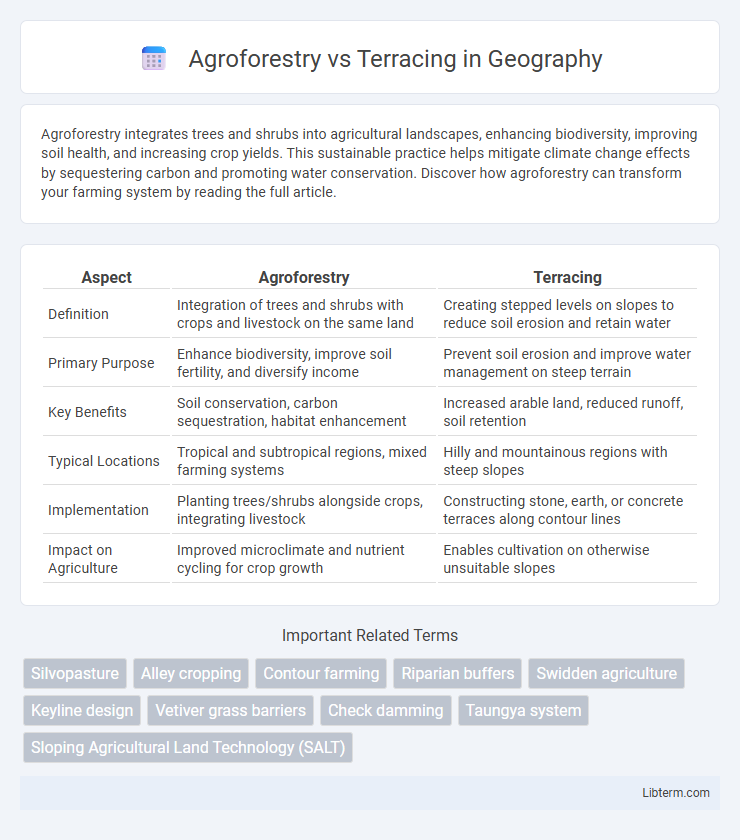Agroforestry integrates trees and shrubs into agricultural landscapes, enhancing biodiversity, improving soil health, and increasing crop yields. This sustainable practice helps mitigate climate change effects by sequestering carbon and promoting water conservation. Discover how agroforestry can transform your farming system by reading the full article.
Table of Comparison
| Aspect | Agroforestry | Terracing |
|---|---|---|
| Definition | Integration of trees and shrubs with crops and livestock on the same land | Creating stepped levels on slopes to reduce soil erosion and retain water |
| Primary Purpose | Enhance biodiversity, improve soil fertility, and diversify income | Prevent soil erosion and improve water management on steep terrain |
| Key Benefits | Soil conservation, carbon sequestration, habitat enhancement | Increased arable land, reduced runoff, soil retention |
| Typical Locations | Tropical and subtropical regions, mixed farming systems | Hilly and mountainous regions with steep slopes |
| Implementation | Planting trees/shrubs alongside crops, integrating livestock | Constructing stone, earth, or concrete terraces along contour lines |
| Impact on Agriculture | Improved microclimate and nutrient cycling for crop growth | Enables cultivation on otherwise unsuitable slopes |
Introduction to Agroforestry and Terracing
Agroforestry integrates trees and shrubs into agricultural landscapes, enhancing biodiversity, improving soil fertility, and promoting sustainable land use. Terracing involves creating stepped levels on sloped terrain to reduce soil erosion, increase water retention, and enable cultivation on otherwise challenging landscapes. Both methods contribute to soil conservation and sustainable agriculture but differ in their structural approaches and ecosystem integration.
Defining Agroforestry: Concepts and Practices
Agroforestry integrates trees and shrubs into agricultural landscapes to enhance biodiversity, improve soil health, and increase crop productivity. This practice involves diverse systems such as alley cropping, silvopasture, and forest farming, which optimize land use and provide multiple ecological benefits. Terracing, by contrast, primarily focuses on shaping land contours to minimize erosion and manage water runoff on sloped terrain.
Understanding Terracing: Techniques and Applications
Terracing is an ancient agricultural technique that involves creating stepped levels on sloped terrain to reduce soil erosion and enhance water retention. This method is widely used in hilly or mountainous regions to improve arable land use and increase crop yields by slowing runoff and allowing water infiltration. Effective terracing requires precise engineering to design contour lines and retaining walls that stabilize soil and prevent landslides.
Environmental Benefits of Agroforestry
Agroforestry enhances biodiversity by integrating trees with crops, improving soil fertility through nitrogen fixation and organic matter. It reduces erosion and water runoff by stabilizing the soil with deep-rooted vegetation, promoting better water retention compared to terracing. This system also sequesters significant amounts of carbon, contributing to climate change mitigation while supporting sustainable agricultural practices.
Soil Conservation through Terracing
Terracing is a highly effective soil conservation technique that reduces soil erosion by transforming steep slopes into a series of level steps, which slows water runoff and increases water infiltration. This method stabilizes the soil structure, minimizes nutrient loss, and enhances moisture retention compared to agroforestry systems. By controlling surface runoff and preventing landslides, terracing ensures sustainable land use in hilly and mountainous agricultural regions.
Agroforestry vs Terracing: Impact on Water Management
Agroforestry integrates trees with crops and livestock, enhancing soil structure and increasing water infiltration, which reduces runoff and soil erosion more effectively than terracing alone. Terracing reshapes slopes into step-like platforms to slow water flow, minimizing erosion but often requiring significant maintenance and less biodiversity support. Combining agroforestry with terracing can optimize water retention, improve groundwater recharge, and sustain long-term agricultural productivity on hilly terrain.
Biodiversity Enhancement: Agroforestry Compared to Terracing
Agroforestry enhances biodiversity by integrating trees, shrubs, and crops within the same land area, creating diverse habitats that support various plant and animal species. Terracing focuses primarily on soil erosion control and water management but offers limited improvement in habitat diversity compared to agroforestry systems. Studies indicate that agroforestry practices contribute significantly to ecosystem resilience and species richness, promoting sustainable agricultural landscapes.
Economic Considerations: Costs and Returns
Agroforestry typically involves moderate initial investment with long-term returns through diversified crops and timber products, enhancing income stability for farmers. Terracing requires higher upfront costs due to land modification and maintenance but can significantly increase arable land productivity and reduce soil erosion, leading to improved crop yields and economic benefits. Both methods improve land use efficiency, yet agroforestry offers more diversified income streams, while terracing delivers immediate soil conservation and enhanced crop profitability.
Suitability and Scalability in Different Landscapes
Agroforestry demonstrates high suitability in diverse landscapes, including sloped, degraded, and marginal soils, by integrating trees with crops to enhance biodiversity, soil fertility, and water retention. Terracing offers effective erosion control and water management primarily on steep slopes but demands significant labor and maintenance, limiting its scalability in extensive or flat regions. Scalability of agroforestry is higher across varied terrains due to its adaptive nature and multiple environmental benefits, whereas terracing remains most feasible in mountainous or hilly landscapes with controlled spatial applications.
Choosing Between Agroforestry and Terracing: Factors to Consider
Choosing between agroforestry and terracing involves evaluating land slope, soil erosion risk, and crop type suitability. Agroforestry integrates trees and crops to enhance biodiversity and improve soil fertility, ideal for moderate slopes and long-term sustainability. Terracing is effective for steep slopes prone to erosion, providing immediate soil stability but requiring higher initial labor and maintenance.
Agroforestry Infographic

 libterm.com
libterm.com